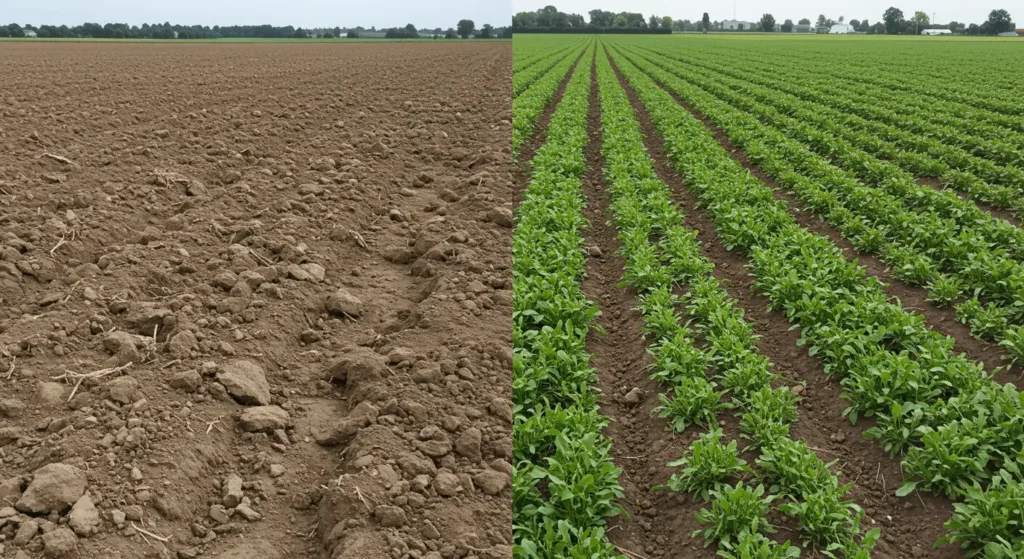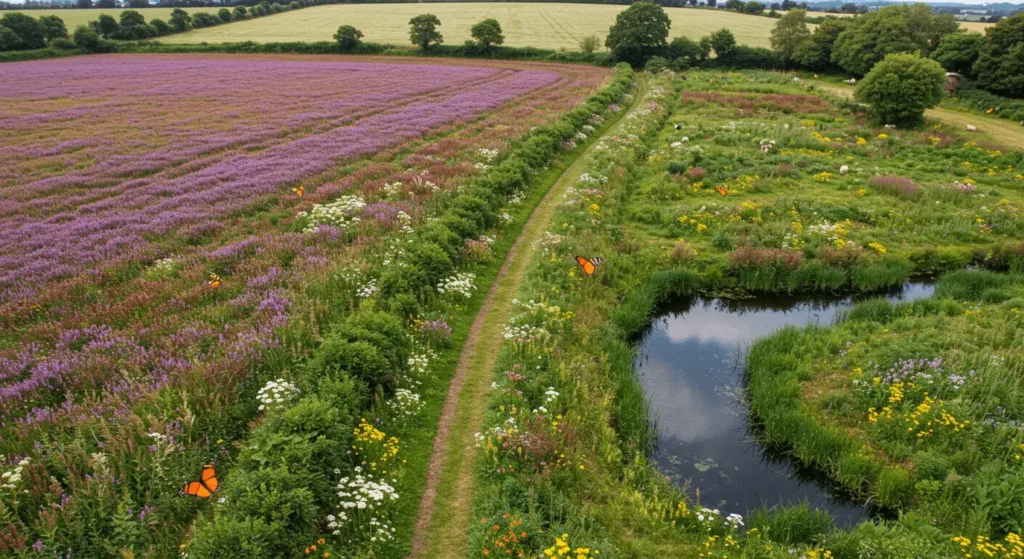The natural resources and life forms on our earth play a basic role in our well-being. Regular farming techniques create a lot of food. However, conventional farming generally damages the soil. It also causes more water pollution and threaten the environment by destroying various living things. What if farming could improve the soil rather than negatively affect it? That’s the basic idea of regenerative agriculture. Organic farming focuses on increasing soil nutrients and conserving the natural environment. In this article, we’ll discuss why regenerative agriculture ecosystem services are so closely connected. Let’s start with the basics.
Regenerative Agriculture and the Living Soil
Life fundamentally depends on soil, which is the place where many kinds of microorganisms live. The primary goal of regenerative agriculture is to sustain and improve soil health by using covers for crops and avoiding heavy use of chemicals.
- The crops are left to decompose in the soil, they become part of the organic matter that nourishes microbes.
- Plants are often planted on not-farming land to protect the soil, keep weeds under control, reduce soil erosion and supply nutrients to the earth.
- Using fewer chemicals prevents the fertilizers and pesticides from harming the soil and water. Fields are rearranged year by year to naturally control pests.
By using these methods, we can add more organic matter to the soil and maximize its quality. Soil health improves the ability of the earth to soak in water. It stops water from running off. It also provides support while crops are in drought. If the soil microbiome is in good condition, the soil’s recycling will cut down on using chemical fertilizers. The figures below highlight that with these methods, the soil remains lively. It benefits both farming and nature. This is when compared with conventional farming techniques.

The Soil Food Web and Nutrient Cycling
As a part of healthy and regenerative, soil holds a rich world full of living things. This means the soil food web is composed of various organisms like bacteria, fungi, protozoa, nematodes, and earthworms. They help in recycling everything naturally. By responding to them, organic matter is processed and nutrients are made available for absorption by plants. Farmers use regenerative farming techniques to boost natural processes. These techniques allow soil to supply more nutrients to crops. They also help soil formation continue.
Understanding Ecosystem Services
Ecosystems consist of plants and animals that interact to each other and help in giving benefits known as ecosystem services. These services in health care are important for our well-being, economy, and the lives we lead.
Types of Ecosystem Services
Ecosystem services are separated into four main categories.
| Type | Description | Examples |
|---|---|---|
| Provisioning | Resources produced by ecosystems | Food, water, timber |
| Regulating | Processes that maintain environmental balance | Climate regulation, pollination |
| Cultural | Non-material benefits | Recreation, spiritual value |
| Supporting | Foundational processes enabling other services | Soil formation, nutrient cycling |
These services are very necessary. People rely on clean water for their health, need fresh air thanks to air purification, and depend on pollination for growing most of the world’s crops. They help to offer trillions worth of economic advantage to sectors such as agriculture and tourism. On the other hand, when we follow practices such as monoculture farming, we threaten the positive qualities of ecosystems. By using nature in farming, regenerative agriculture improves the support these three services give the environment.
Importance of Ecosystem Services
These services are incredibly important. They help in producing most of our food, supply fresh water and clean air. They also play their role to prevent natural disasters with techniques such as flood management and soil erosion. People are beginning to see the economic impact of ecosystem services. It is now clear that a protected environment is very important for our long-term future.
Regenerative Agriculture Boosts Ecosystem Services
Regenerative agriculture works with nature to improve the benefits that are provided by the ecosystem. In the next sections, we will explain how different approaches provide the benefits and point to real examples.
1. Raising Soil Health and Nutrient Cycling
Improving soil quality is made possible by cover cropping and practicing no-till farming. By doing this, the need for chemical fertilizers has decreased. As an example, an Iowa farm saved 30% on nitrogen fertilizer but did not lose any of its yields. Rodale Institute’s studies state that regenerative organic farming increases soil organic matter, also help in keep water and carbon in the farmland.
2. Promoting Biodiversity and Wildlife Habitat
When different crops and animals share space, it encourages the growth of wildlife habitats. Having hedgerows and buffer zones nearby will attract plants’ friends, like pollinators and birds. According to a research report: birds could be found on 25% more types of regenerative farms than regular farms. At the Knepp Estate in the UK, rare animals thrived using regenerative rewilding. There was also an increase in pollination, according to their case study.

3. Improving Water Retention and Quality
If soil holds high levels of organic matter, it collects and keeps water, which also decreases the risk of flooding. Regenerative farming methods also prevent the chemicals used from polluting the water. No-till and cover crops used by Midwest farmers on their land led them to a 90% drop in sediment.
4. Contributing to Climate Regulation
Did you know? Regenerative farming prevents the soil from releasing carbon that would otherwise harm the environment. Both of these methods contribute to soil carbon sequestration. Evidence shows that if we manage all agricultural land this way, it could prevent chain reactions that cause climate change. This management could sequester 1 Pg-C a year. If there is less grazing, it could result in a 25% to 33% drop in CO₂ emissions. Researchers point out that only about 20% of carbon in grasslands originates from areas of high grazing. The diagram below shows the carbon cycle.
Regenerative Agriculture’s Role in Climate Action
Regenerative agriculture relies heavily on carbon sequestration to improve the environment. No-till and rotational grazing can store up to 30-60 Pg-C in the soil over 25–50 years. The result is that regenerative farming helps the climate and also produces our food.
Reducing Greenhouse Gas Emissions
Using regenerative techniques leads to a reduction in emissions. When less synthetic fertilizer is used, less nitrous oxide is produced. If there is no tilling, the soil stores more carbon for a longer period. The table below outlines the difference in emissions between regenerative and conventional farms.
| Emission Source | Conventional Farming | Regenerative Farming | Climate Advantage |
|---|---|---|---|
| Synthetic Fertilizers | High nitrous oxide (N₂O) emissions from fertilizer production and application (1.5-2.5 kg N₂O-N/ha annually). | Reduced or no synthetic fertilizers; organic inputs lower N₂O emissions (0.3-0.8 kg N₂O-N/ha annually). | Up to 70% reduction in N₂O emissions due to less reliance on fossil fuel-based fertilizers. |
| Tillage | Frequent tillage releases soil carbon as CO₂ (0.5-1.0 t CO₂/ha annually). | No-till or minimal tillage prevents soil carbon release (0.1-0.3 t CO₂/ha annually). | 60-80% lower CO₂ emissions by preserving soil carbon stocks. |
| Livestock Management | High methane (CH₄) from conventional grazing and feed (20-30 kg CH₄/head annually). | Rotational grazing optimizes pasture, reducing CH₄ (15-25 kg CH₄/head annually). | 10-25% reduction in CH₄ emissions through improved grazing practices. |
| Total GHG Emissions | Approx. 5-7 t CO₂eq/ha annually (aggregated CO₂, N₂O, CH₄). | Approx. 2-4 t CO₂eq/ha annually (grouped CO₂, N₂O, CH₄). | 40-60% overall reduction in GHG emissions, supporting climate-smart agriculture. |
Building Resilient Farms and Healing the Land
As a result, the farms are much stronger and more resilient to damage. Their systems can respond to droughts, flooding and insect attacks. Farmers need less expensive outside support. They can depend on this to run their farms. It helps sustain the food industry. In fact, these accomplishments belong to ecological restoration. They support healing the land by using principles of holistic management to look after natural resources.
A Path Towards Sustainable Harmony
With regenerative agriculture, farming helps the environment by improving clean water, pollination, and controlling the climate. Improving the soil and increasing carbon sequestration is beneficial for farms and ecosystem services. This way of working will help us live in peace and sustainability in the future.
Gain knowledge about regenerative farming and choose to support those who use it. Consider using sustainable farming or urge for earth-friendly policies.
References
- ResearchGate: Holistic Management Critical Review
- Rodale Institute: White Paper on Regenerative Farming
- NRDC: Regenerative Agriculture 101 Guide




